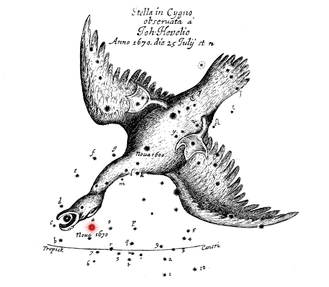
International team of astrophysicists led by Tomasz Kamiński (ALMA-ESO, Chile; former PhD student at the Copernicus Astronomical Center), which also included Romuald Tylenda and Marcin Hajduk from the Copernicus Center Toruń, carried out observations of CK Vul (Nova Vul 1670; known also as the Hevelius Nova) in the submillimetre range using the APEX radiotelescope (Chilean Andes). The object, currently invisible in the optical, appeared to be a luminous and rich source of molecular emission. The analysis of the data leads to a conclusion that the 1670 eruption was not a classical nova (thermonuclear runaway on an accreting white dwarf in a binary system) but rather a so-called red nova, i.e. an energetic eruption caused by a merger of two stars, presumably having been components of a binary system. The results have been published in Nature (copy in ArXiv).
Picture: Hevelius' drawing with a position of nova marked in red.
Contact:
Romuald Tylenda
N. Copernicus Astronomical Centre
Department of Astrophysics, Toruń, Poland
e-mail: tylenda@ncac.torun.pl
tel. +48 56 6219319 ext. 11
mobile: +48 600 286 131






